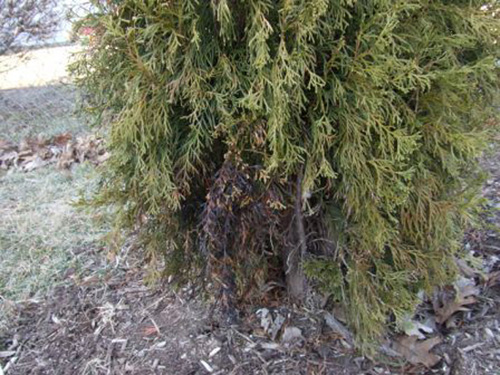Issue 2, May 1, 2009
Arborvitae Mystery
Here is a problem we see periodically. Arborvitae plants sometimes develop areas of black foliage like those shown in the images. These images were submitted by a home owner in Sangamon County who sent them to the Sangamon regional extension office. The owner gave permission for us to use these images. Although I have seen this in the past, I did not have any images of my own.


We believe this is a physiological response to environmental stress. In other words, we don’t find an infectious cause and cannot associate a specific abiotic factor to the symptoms.
We did not have a physical sample in this case. Past cases occasionally yield Pestalotiopsis, a fungus that is found on injured evergreens. It is a common opportunistic fungus and not the cause of the blackened foliage. Fungicides will do nothing to improve the condition. In fact, this black foliage is not known to spread and is not a threat to tree health. It often occurs in dense areas or places where air circulation is slow. Winter injury and desiccation of foliage has also been associated with this black foliage. Sometimes root or root collar injury, root rot, or root decline are associated with this symptom. In those cases I would expect to see a general decline of the plant as well. More often, only a few isolated areas of the arborvitae are affected with this blackened foliage.
This condition has been reported by some of diagnosticians like me in Virginia, Delaware, Ohio, Indiana, Nebraska, Oregon, and North Carolina. None have associated it with a pathogen.
My advice is to wait until you are certain the affected foliage is dead. Pick a dry day and prune it from the plant. Inspect the plant for injury or signs of stress and address the stress as you are able. In dense plantings, consider pruning nearby plants to allow better air flow. Do not apply chemicals near the base of the plant. Consider supplemental watering in long periods of drought.--Nancy R. Pataky
Author:
Nancy Pataky